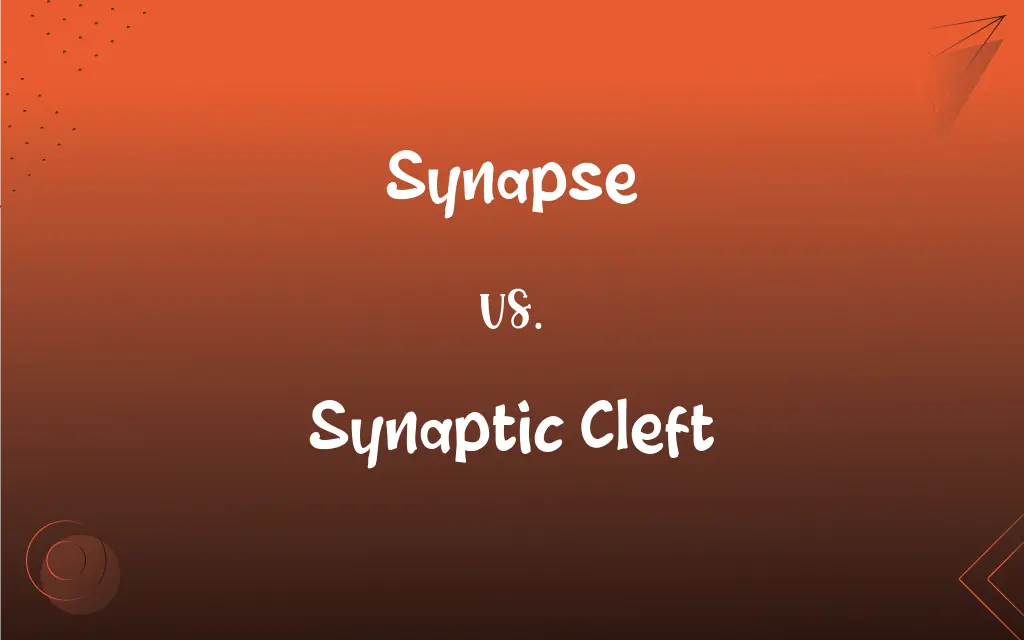Synapse vs. Synaptic Cleft: What's the Difference?
Edited by Aimie Carlson || By Janet White || Published on March 26, 2024
A synapse is the junction between two neurons, while a synaptic cleft is the gap within the synapse through which neurotransmitters pass.

Key Differences
The synapse is a complex structure that facilitates communication between neurons or between a neuron and another cell type. The synaptic cleft is specifically the narrow gap that separates the presynaptic neuron from the postsynaptic cell within the synapse, through which neurotransmitters are released to carry signals.
A synapse includes not only the synaptic cleft but also the presynaptic and postsynaptic membranes that contain various proteins essential for neurotransmission. The synaptic cleft, by contrast, is the physical space that neurotransmitters must cross, and it plays a critical role in the timing and fidelity of neurotransmission.
Synapses are crucial for the nervous system's function, enabling the transmission of electrical or chemical signals across neurons. The synaptic cleft, on the other hand, serves as the controlled environment where these signals are converted from one form to another, ensuring that communication between neurons is precise and regulated.
The term "synapse" encompasses the entire junction, including all structural and functional components necessary for neuronal communication, "synaptic cleft" refers specifically to the gap that physically and functionally separates the communicating neurons.
A synapse is the overall structure that facilitates neuronal communication, including various components like neurotransmitter receptors and release sites, whereas the synaptic cleft is a component of the synapse, critical for the diffusion of neurotransmitters between neurons.
ADVERTISEMENT
Comparison Chart
Definition
The junction between two neurons or a neuron and another cell, facilitating communication.
The narrow gap within a synapse through which neurotransmitters are released.
Components
Includes presynaptic and postsynaptic terminals, synaptic cleft, and neurotransmitters.
Constitutes the gap itself, without additional structural components.
Function
Enables the transmission of electrical or chemical signals between cells.
Serves as the pathway for neurotransmitters to travel from one neuron to another.
Structural Complexity
Comprises various proteins, receptors, and release mechanisms.
Lacks complex structures, primarily a gap filled with extracellular fluid.
Role in Communication
Integrates and modulates signals between neurons.
Facilitates the physical transfer of signals via neurotransmitters.
ADVERTISEMENT
Synapse and Synaptic Cleft Definitions
Synapse
A synapse is the site of transmission of electric nerve impulses between two nerve cells.
The nerve impulse arrived at the synapse, triggering the release of neurotransmitters.
Synaptic Cleft
Synaptic clefts ensure that neuronal communication is unidirectional and precise.
The synaptic cleft prevents the backflow of neurotransmitters, maintaining the directionality of signal transmission.
Synapse
Synapses can be chemical or electrical, depending on the mode of signal transmission.
Electrical synapses allow for faster signal transmission than chemical synapses.
Synaptic Cleft
The synaptic cleft's chemical environment is tightly regulated to ensure efficient neurotransmission.
Enzymes within the synaptic cleft quickly degrade neurotransmitters to terminate the signal.
Synapse
Synapses are adaptable, with their efficiency changing in response to activity.
Repeated stimulation of a synapse can lead to long-term potentiation, enhancing synaptic strength.
Synaptic Cleft
The synaptic cleft is the microscopic gap between neurons through which neurotransmitters are exchanged.
Neurotransmitters diffused across the synaptic cleft, initiating a response in the postsynaptic neuron.
Synapse
Synapses are the communication points between neurons and muscle cells, enabling movement.
A malfunction at the neuromuscular synapse can lead to muscle weakness.
Synaptic Cleft
The width of the synaptic cleft is crucial for the speed and efficacy of neurotransmitter diffusion.
Alterations in the synaptic cleft's width could affect the speed of neural communication.
Synapse
Synapses facilitate learning and memory by strengthening or weakening their signals.
Learning a new skill involves the formation of new synapses in the brain.
Synaptic Cleft
Synaptic clefts are filled with extracellular matrix proteins that influence synaptic transmission.
The extracellular matrix in the synaptic cleft plays a role in the development and maintenance of synapses.
Synapse
The junction across which a nerve impulse passes from an axon terminal to a neuron, muscle cell, or gland cell.
Synapse
To form a synapse.
Synapse
To undergo synapsis.
Synapse
The junction between the terminal of a neuron and either another neuron or a muscle or gland cell, over which nerve impulses pass.
Synapse
(intransitive) To form a synapse.
Synapse
(intransitive) To undergo synapsis.
Synapse
The junction between two neurons (axon-to-dendrite) or between a neuron and a muscle;
Nerve impulses cross a synapse through the action of neurotransmitters
FAQs
What is a synaptic cleft?
The synaptic cleft is the specific gap within a synapse through which neurotransmitters are released.
What is a synapse?
A synapse is a junction that enables communication between two neurons or a neuron and another cell.
Can the function of a synapse change?
Yes, synapses can strengthen or weaken over time, affecting their function.
Are all synapses the same?
No, there are chemical and electrical synapses, each with distinct mechanisms.
What is synaptic plasticity?
Synaptic plasticity refers to the ability of synapses to change their strength or efficiency in response to activity.
How does the synaptic cleft affect signal speed?
The width and chemical environment of the synaptic cleft can influence the speed of signal transmission.
What roles do synaptic clefts play in neurotransmission?
Synaptic clefts allow neurotransmitters to pass from one neuron to the next, facilitating communication.
How do diseases affect synapses and synaptic clefts?
Diseases can alter synaptic function and cleft structure, impacting neural communication.
What is a presynaptic neuron?
The presynaptic neuron is the cell that releases neurotransmitters into the synaptic cleft.
How do synapses work?
Synapses work by transmitting signals through the release of neurotransmitters across the synaptic cleft.
What is neurotransmitter reuptake?
Reuptake is the process by which neurotransmitters are absorbed back into the presynaptic neuron after crossing the synaptic cleft.
What is a postsynaptic neuron?
The postsynaptic neuron is the cell that receives signals through receptors on its surface.
Can synapses form between neurons and other cell types?
Yes, synapses can also form between neurons and muscle or gland cells.
What happens if the synaptic cleft is disrupted?
Disruption can impair neurotransmission, affecting communication between neurons.
What is long-term potentiation (LTP)?
LTP is a long-lasting increase in synaptic strength, associated with learning and memory.
How do drugs affect the synaptic cleft?
Drugs can alter neurotransmitter levels in the synaptic cleft, influencing communication.
What is synaptic efficacy?
Synaptic efficacy refers to how effectively a synapse transmits its signal.
How are synapses formed?
Synapses form through complex developmental processes involving cell signaling and genetic factors.
Do synaptic clefts contain receptors?
No, receptors are located on the postsynaptic membrane, not within the cleft itself.
How is synaptic transmission regulated?
Synaptic transmission is regulated by various factors, including neurotransmitter concentration and receptor sensitivity.
About Author
Written by
Janet WhiteJanet White has been an esteemed writer and blogger for Difference Wiki. Holding a Master's degree in Science and Medical Journalism from the prestigious Boston University, she has consistently demonstrated her expertise and passion for her field. When she's not immersed in her work, Janet relishes her time exercising, delving into a good book, and cherishing moments with friends and family.
Edited by
Aimie CarlsonAimie Carlson, holding a master's degree in English literature, is a fervent English language enthusiast. She lends her writing talents to Difference Wiki, a prominent website that specializes in comparisons, offering readers insightful analyses that both captivate and inform.
































































